
SHARP LOOKING: LIGHTWEIGHT ON LITESPEED
Similarities
Litespeed and Lightweight – the two high end cycling brands have much more in common than you think, not just similar brand names.
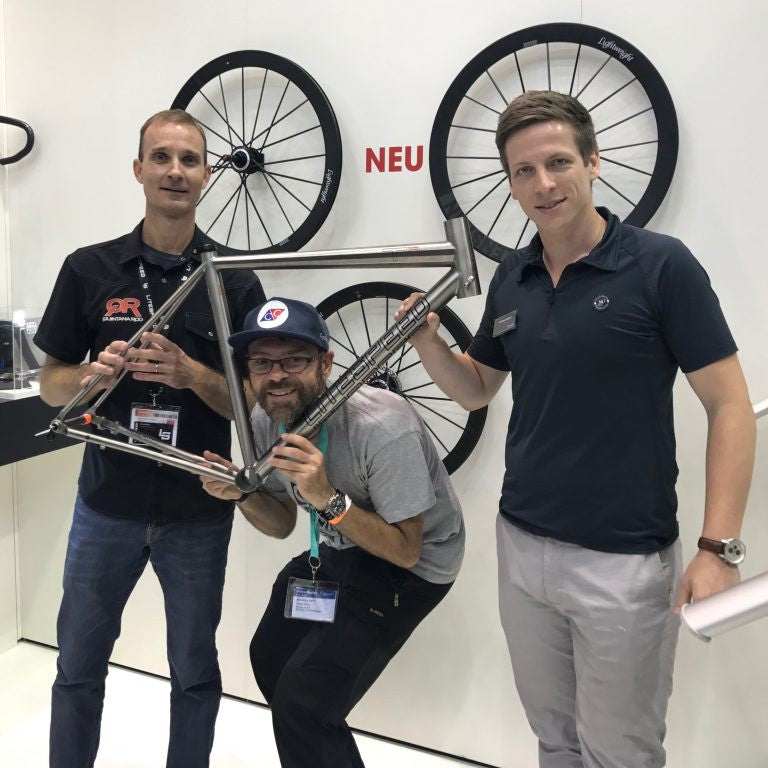
Litespeed’s Chris Brown meeting Matthias Wissler, Lightweight Head of Sales Americas, at Eurobike 2017
Roots in the ’80s
Litespeed began building bike frames in 1986 from a material primarily used in aerospace: titanium. Around the same time German genius Heinz Obermayer and partners, with background from BMW motor sports, started to experiment with fiberglass reinforced polyester for silky wheels in Heinz’ tractor garage in Munich. Shortly after, they had developed the first ever all-carbon bicycle wheel. Carbon has since revolutionized cycling and made it to aviation and aerospace.
In pro cycling since the ’90s
In professional cycling Litespeed earned first merits in the 1999 Tour de France Time Trial, with Lance Armstrong winning on a Trek-branded titanium Litespeed Blade. Heinz Obermayer’s carbon wheels, until 1997 branded as HYLIGHT, helped Belgian rider Johan Museeuw win the 1996 road cycling world championship. Heinz Obermeyer’s wheels also carried Bjarne Riis to victory in the 1996 Tour de France and helped Jan Ullrich achieve the same in the following year. However Jan Ullrich had to ride Lightweight re-labeled with the brand of his sponsor. In 2002 Lance Armstrong gained a Tour de France victory on Lightweight wheels.
Aerospace
In 2003 Lightweight was sold to CarbonSports who belongs to Wissler Group, a high-tech company with expertise among others in carbon fiber for aviation and aerospace. This enables Lightweight to access high quality carbon fiber only available to companies certified as aerospace suppliers.
In 2009 also Litespeed reached areospace levels. collaborating with NASA’s Jet Propulsion Lab to design and manufacture the rocker-bogie system for the Mars Rover Curiosity.
100% Handcrafted
Besides the fact that Litespeed titanium frames as well as Lightweight carbon wheels are lookers with a certain "sex appeal“, the most important similarity is that they are 100% handcrafted.
Lightweight = Propulsion, Motion Dynamics and Stiffness
After its first successes in the pro peloton, Heinz Obermayer closed his tractor garage and started his well earned retirement. Lightweight, now owned by CarbonSports, launched its 2nd Generation wheels in 2006 and Generation 3 in 2008 including all-carbon clincher wheels. In 2012 the fourth Generation was launched and new product names introduced. Since two years disc break versions are available and the improved Meilenstein C Disc was just introduced at Eurobike 2017.
Technology-wise the newest generation is still built like the first Obermayer wheels yet stiffer and even more durable, Heinz Obermayer told me at Eurobike 2017.
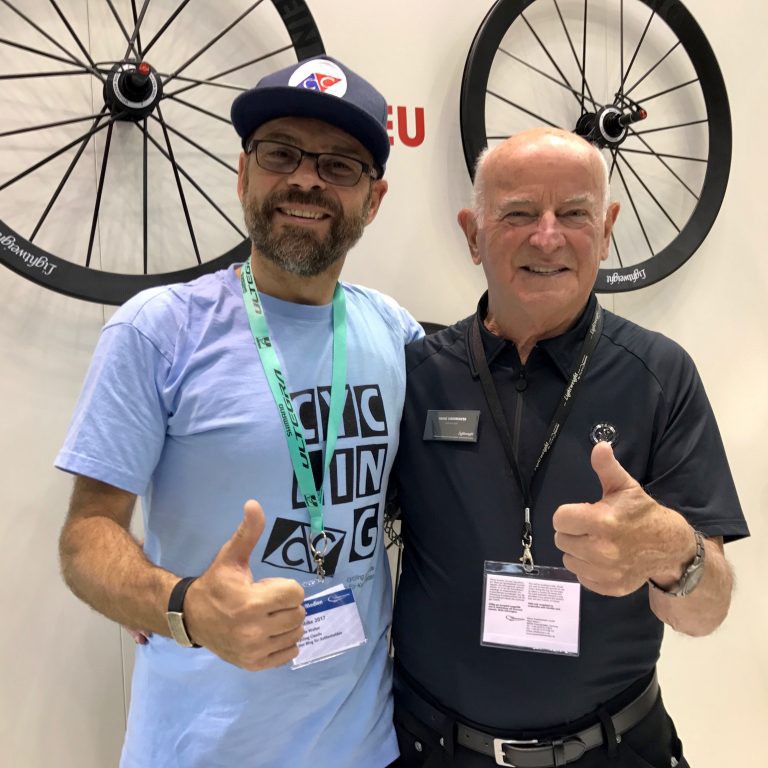
“Once you set off“, Heinz said,“you can’t help looking round to check if someone is pushing you.”
Giving it a Try

As Lightweight/CarbonSports’ hq and production is only five minutes by bike from Friedrichshafen fair ground, the home of the Eurobikeshow, I wanted to give it a try.
At Eurobike I bluntly asked Jörg, Head of Marketing and Head of Sales Europe, for a test ride. Jörg, who by the way also runs ilovecycling.de, the most successful German speaking cycling blog, didn’t say no.
But he had one pre-condition: "Please bring your own bike“, he said. Firstly you need to experience the wheels on your own bike, and secondly titanium bikes look gorgeous with Lightweights.“
Next day 3 pm, me and my T5 were waiting for Jörg and his colleague David, who is with Lightweight since 2004. Whilst waiting, my T5 became friends at the reception with a Lightweight Urgestalt on Meilenstein wheels.
On first sight I had to admit that the Meilenstein looked much sharper than my Zipp 30 alloy wheel set.
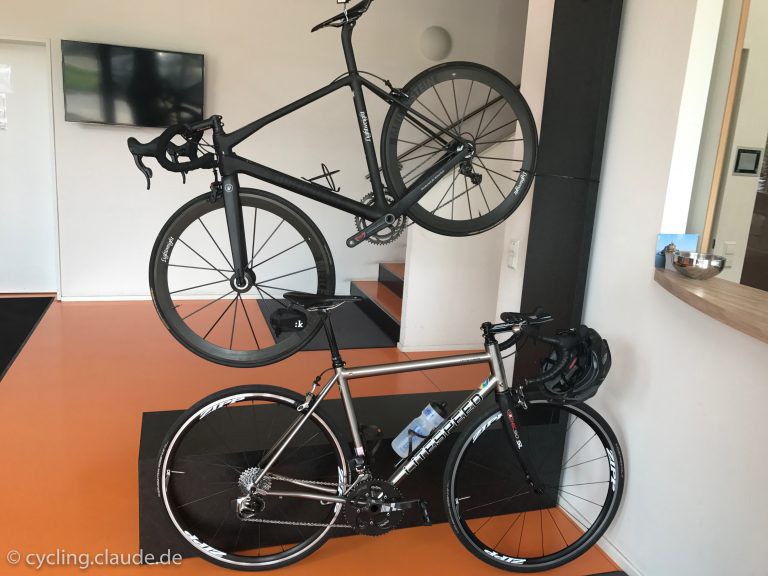
When Jörg and David arrived, they proposed to start the test ride with the GIPFELSTURM, a 27 mm low profile wheel, designed for climbers and continue with the legendary MEILENSTEIN C 47,5 mm clinchers.
Factory Tour
Whilst my T5 was taken upstairs to the workshop to get brake pads and wheels exchanged, David walked me around the production area. As carbon wheels are only one part of the portfolio, unfortunately no photos were allowed.
I learned a lot from David. For example that it takes 16 hours of manual work to manufacture a Lightweight wheel, which goes through the hands of eight to ten specialists. Spokes are glued/laminated to the rim. For a 20 spoke wheel it needs 10 spokes, each with one end glued to the rim, lead around the hub and glued to the rim with its other end. This provides the superior stiffness Lightweight is known for.

Lightweight wheels come with SwissStop brake pads which are designed to work best with Lightweight carbon. These pads, I heard, stand for superior braking power, even in wet conditions, and minimal rim wear. Furthermore it's worth mentioning that Lightweight carbon rims can be refurbished in their factory.
Test Ride GIPFELSTURM Tubular

When I saw my T5 with GIPFELSTURM wheels I loudly said "WOW!
My bike looked absolutely awesome with the 27 mm low profile wheels that are designed for climbing.
The GIPFELSTURM tubular wheels come with 20 spokes at the front and 24 at the rear wheel. Total weight is 1,025 g (450 g + 575 g). Maximum system weight is 110 kg for the wheels.
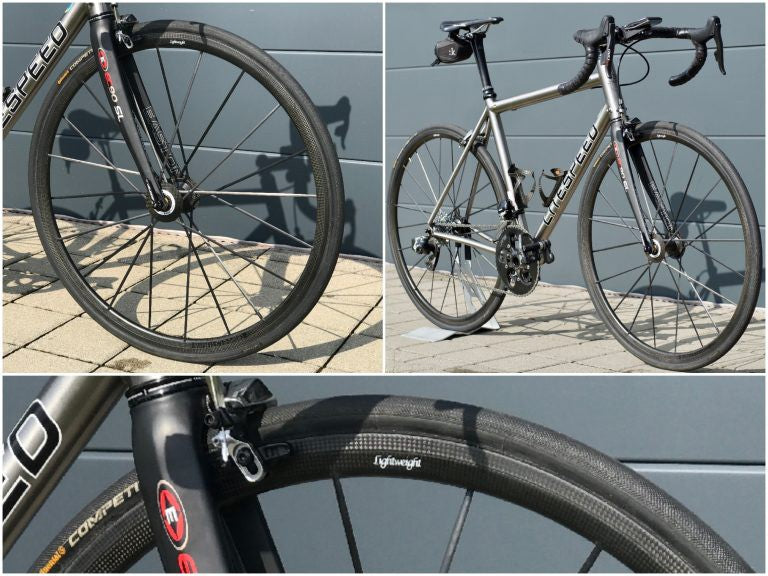
But how do they ride?
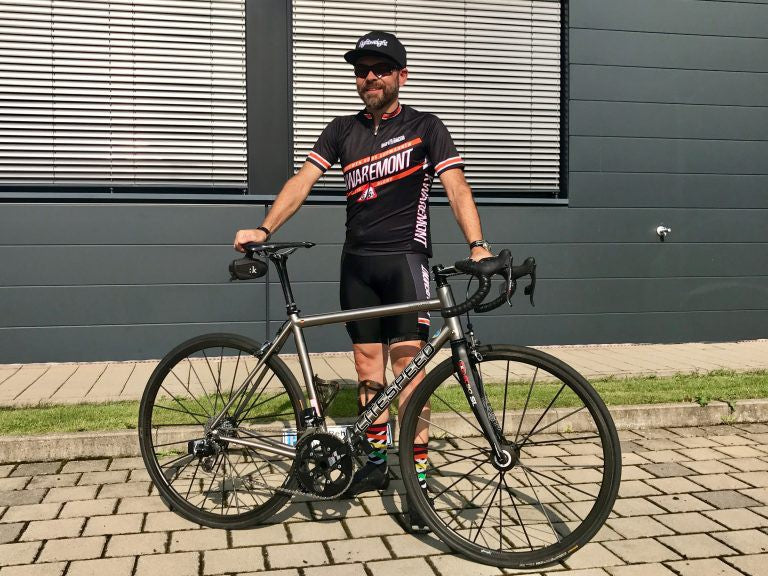
I am not a racer, not even a competitive cyclist, but I really felt the difference. What a propulsion! You can really feel the stiffness. These wheels translate crank power directly and fully on the tarmac. Incredible!
I was also surprised by the braking power. Under dry conditions there was absolutely no difference between these all-carbon wheels and my alloy Zipp 30.
Test Ride the Legendary MEILENSTEIN Clincher
Whilst the Lightweight mechanics changed my bike to MEILENSTEIN clinchers, a short but heavy summer rain came down. Luckily it was so hot that the tarmac dried quickly.
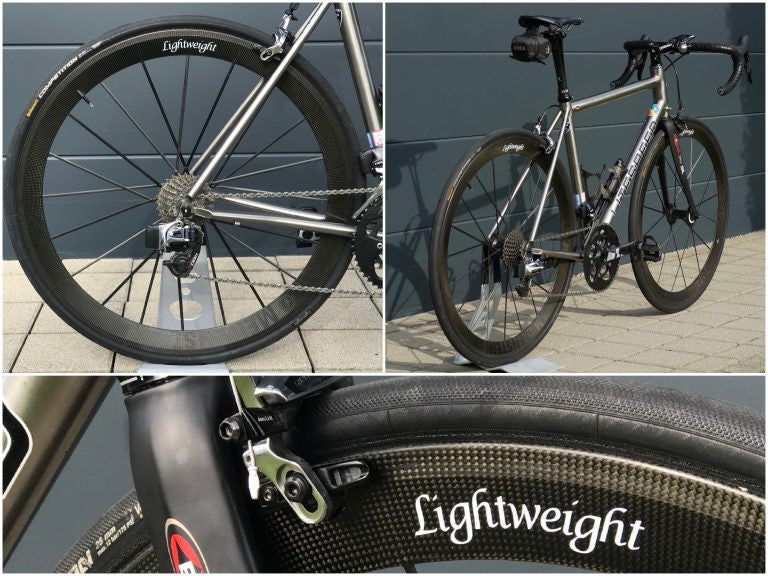
I have to admit, that the v-shaped MEILENSTEIN looked very sharp on my T5. Usually I don’t fancy higher profile wheels but these 47.5 mm wheels look great.
With 20 spokes on the rear wheel, you have the choice between MEILENSTEIN front wheels with 16 and 20 spokes. The 16 spokes version allows a max. system weight of 100 kg, the 20 spoke front wheel 120 kg. While the 20/20 wheel set weighs 1,125 g (500 g + 625 g)m the 16/20 combination saves 25 g. 1,100 or 1,125 g for a set of 47.5 mm aero wheels is outstandingly light.
The MEILENSTEIN is actually the grandchild of the famous wheels built for Museeuw, Riis, Ullrich, Armstrong and others, yet stiffer than before with a more modern finish. It accelerates extremely fast, maintains speed on the flats and is unrivaled by other aero wheel sets when it comes to climbing.
You could argue that the narrow rim shape is rather outdated compared to wider rims from competition.
Still Meilenstein wheels show excellent test results. German cycling magazine RoadBike (04/2017) tested rim-brake versions of aero wheels in regards to heat resistance, pad wear, lateral stiffness, torsion stiffness, maneuverability, built and riding impressions.
Lightweight MEILENSTEIN clinchers scored incredible 100/100 points, beating lengthways competition from Acros, Easton, Knight, Mavic, Reynolds and Zipp.
RoadBike 04/2017:
"Maximum score – Lightweight’s Meilenstein outran its competitors. No surprise, if you consider the price tag, one may argue. On the other hand, optimum values on impressions speak for themselves. The propulsion while pedaling is just insane, although the very narrow rim appears a little antiquated compared to its competitors."
Lightweigt MEILENSTEIN are also surprisingly immune when it comes to crosswinds
German cycling magazine TOUR (10/2017) tested crosswind stability of clincher aero wheels (disc versions). For the MEILENSTEIN the magazine measured only 4 Nm force through crosswinds on the wheel simulated in a wind tunnel. Enve SES 4.5 had 6 Nm and Zipp 303 even 7 Nm. Only Reynolds Aero 46 and EDCO AeroSport Umbrial 45 scored better in this category.
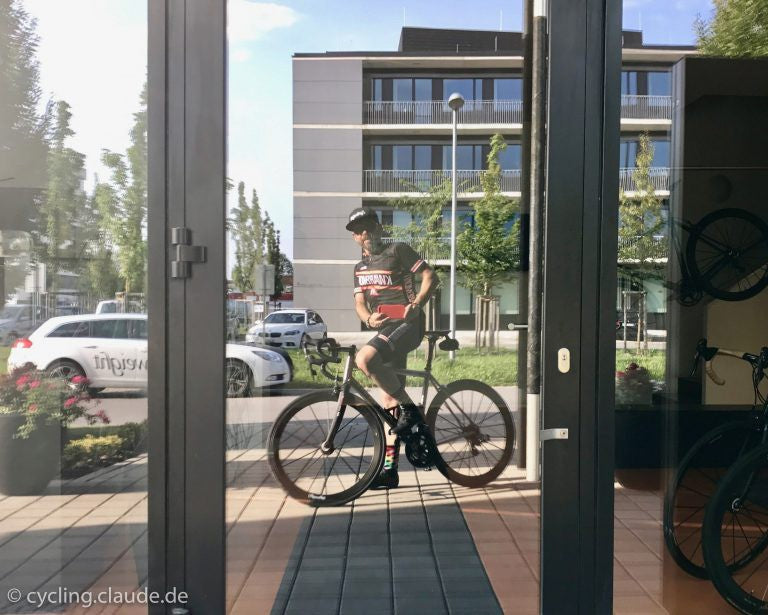
Back from my test ride I had to tell the Lightweight guys that these wheels are super dangerous. Why? When passing window fronts you can’t keep your head from turning, constantly watching your reflection.
My MEILENSTEIN riding impression was superb, even slightly better than the GIPFELSTURM experience. Both on very high level.
Although the tarmac was mostly dry when I rode the MEILENSTEIN, I took every puddle on the road. Braking power with semi-wet wheels was far better than expected.

Back in the workshop the mechanic changed brake pads and wheels to my own stuff.
The test ride left me with a strong desire for Lightweight wheels. Do I need such super fast, super prestigious, super expensive wheels? No! Do I still want them? Yes!
However I still cannot decide which ones to get. GIPFELSTURM or MEILENSTEIN?
If you were me, which ones would you prefer?
About the Author

Claude, 52, is a marketing manager from Germany, addicted to cycling. In his free time Claude runs a popular German language cycling blog. He enjoys long distance cycling on his Litespeed T5.
CyclingClaude – Der Blog für Kettenhelden (The Blog for Chain Heroes)
Follow him on Instagram, Twitter or Facebook.








